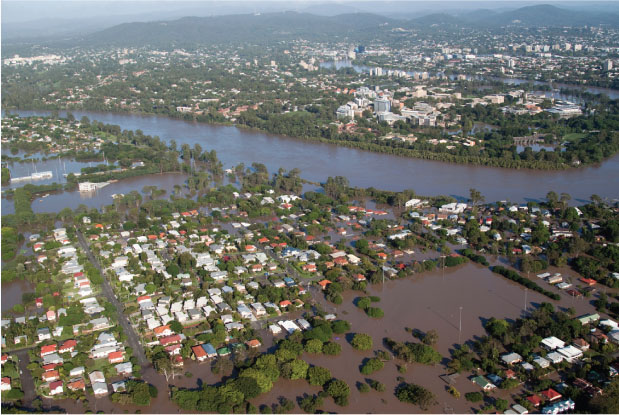Class-action lawsuits are a practical vehicle for litigation oflosses resulting from natural disasters—due to the large number ofplaintiffs residing in a limited geographic area where the value ofan individual claim alone may not be worth pursuing. And with 2011widely anticipated to be the costliest year for natural disastersever reported, insurers could be facing the prospect of a flood ofsuch suits.
| But insurers can take steps inadvance of a catastrophe to minimize the likelihood of class-actionexposure, including: diligent claims handing, ensuring compliancewith relevant statutes, and continually reviewing and revisingpolicy language to reflect lessons learned through litigation.
But insurers can take steps inadvance of a catastrophe to minimize the likelihood of class-actionexposure, including: diligent claims handing, ensuring compliancewith relevant statutes, and continually reviewing and revisingpolicy language to reflect lessons learned through litigation.
Step #1: Evaluate natural-disaster claims withan eye on preventing bad-faith claims
|A predominant issue in natural-disaster class actions arisesfrom claims of bad faith. Juries have returned multimillion-dollarawards to plaintiffs in class actions in which plaintiffs allegedthat they were not properly paid for damages incurred followinghurricanes Katrina and Rita. To prevent bad-faith claims, insurersshould:
- Conduct a thorough investigation. A common claim in classactions is that the insurer failed to properly investigate theinsured's claims and merely denied coverage. In August 2010,plaintiffs filed a class-action suit against Farmers alleging thecompany failed to thoroughly investigate plaintiffs' claims and payfull policy benefits in connection with wildfires in California.Further, plaintiffs alleged that Farmers hired consultants andinvestigators who improperly handled and denied benefits toinsureds. To avoid claims of an unwarranted denial of coverage,resist taking shortcuts and investigate claims carefully. Inaddition, make sure your claims-handling procedures and policiesare clear and are followed by employees.
- Document your investigation and all communications. Effectivedocumentation of proper claims handling is key to avoidingbad-faith claims. The best way to avoid friction with insureds,which could lead to class-action litigation, is to communicateclearly and properly with them. If accusations of bad faith areraised, counsel should be consulted.
- Claims should be processed without delay. If an insured bringsa bad-faith claim, the timing of the insurer's response to theclaim will be highly scrutinized. In cases involving naturaldisasters, undue delay is particularly critical as the insuredcould be in a highly vulnerable position, such as without ahome.
Step #2: Evaluate whether your claims-handlingprocesses and procedures comport with statutory law
|State legislatures have responded to insureds' complaintsstemming from damage caused by natural disasters by enacting lawsthat place restrictions or additional requirements on insurers'claims-handling procedures.
|Following Hurricane Katrina, the Louisiana legislature amended astatute to increase penalties for bad-faith claims handling and toallow insureds to recover attorneys' fees if successful inbad-faith litigation.
|Compliance with state statutes governing claims handling orunfair claims-settlement practices is imperative to avoidingclass-action litigation. Class actions are much more likely to becertified if plaintiffs allege statutory violations.
|Step #3: Review and revise policy languageregularly
|In insurance-coverage cases, ambiguous clauses generally will beinterpreted against the insurer. It is therefore imperative thatall exclusion clauses be clear and unambiguous.
|For example, in the case of In Re: Katrina Canal BreachLitigation, homeowners filed a class-action lawsuit againstmultiple insurers alleging that their “all risk” policies covereddamage to their property caused by water, following leveesbreaching in New Orleans.
|The defendants moved to dismiss, claiming that an exclusion inthe policies prohibited coverage by a flood. The district courtdenied the insurers' motion, stating that the term “flood” wasambiguous. The Fifth Circuit had a different view and reversed thedistrict court's ruling, holding that the term “flood” is commonlyunderstood as a massive inundation of water onto dry land.Poignantly, the appeals court stated that “a flood is a flood,”rejecting plaintiffs' characterization that the policy's languagewas ambiguous.
|The courts' different interpretations of even a seemingly simpleterm such as “flood” demonstrate that it is critical for insurersto continually review and analyze their policy language, as well asrecent case law, to ensure their policy language is clear andexplicit.
|These preventive tips are simple measures insurers can take toreduce exposure to class-action litigation arising from naturaldisasters. Some of the tips can be performed during an insurer'sregular business-practice review, while others, such as properclaims handling, should be addressed daily.
Want to continue reading?
Become a Free PropertyCasualty360 Digital Reader
Your access to unlimited PropertyCasualty360 content isn’t changing.
Once you are an ALM digital member, you’ll receive:
- All PropertyCasualty360.com news coverage, best practices, and in-depth analysis.
- Educational webcasts, resources from industry leaders, and informative newsletters.
- Other award-winning websites including BenefitsPRO.com and ThinkAdvisor.com.
Already have an account? Sign In
© 2024 ALM Global, LLC, All Rights Reserved. Request academic re-use from www.copyright.com. All other uses, submit a request to [email protected]. For more information visit Asset & Logo Licensing.








